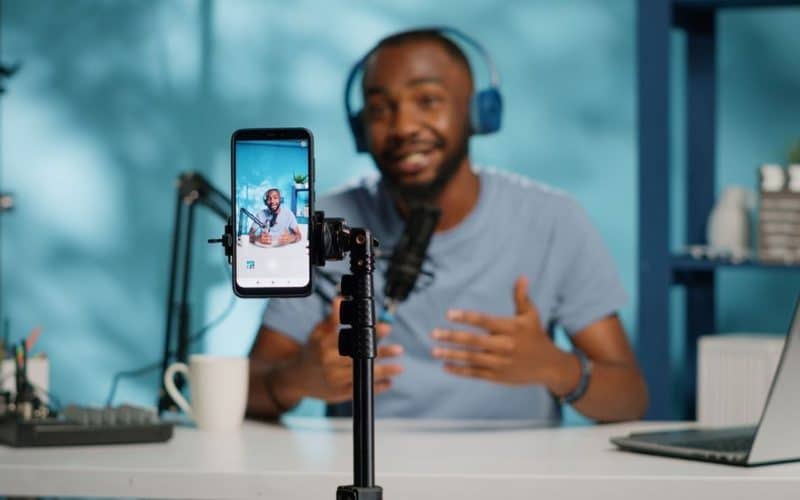I recall how excited I was when I chose to become a content creator. The prospect of creating compelling content and collaborating with brands was exciting. The path to becoming a sought-after content creator was not easy. However, I was determined to make it work. I spent many hours researching, learning, and experimenting. Through trial and error, I learned what works and what does not in the world of content development. Here’s how to avoid common problems and become a content creator who marketers can’t wait to collaborate with.
What is a Content Creator?
A content creator is someone who creates and distributes digital content. While everybody with an Instagram or TikTok account is considered a creator, professional content creators go a step further. They leverage their digital platforms to grow a following and generate revenue from their content.
In recent years, the term “content creation” has gained popularity, particularly in the context of social media. But it covers a vast range of activities.
If you want to become a digital content creator, here are some of the most prevalent types:.
What are the Different Types of Content Creators?
Before we get into the details of being a creator educator, let’s take a look at some of the various types of content creators. Don’t try to cage yourself when it comes to content creation. Instead, focus on your abilities and select content types and digital platforms that will help you reach your target audience.
#1. Influencer
During a press appearance in 2021, Portuguese footballer Cristiano Ronaldo withdrew two Coca-Cola bottles from his table and asked for water instead. That one move reduced Coca-Cola’s stock market worth by $4 billion. That’s the power of an influencer!
An influencer is someone who has earned some credibility in their field through their unique talent or insight. They typically have a sizable and loyal social media following—individuals who know, like, and trust their brand—and may influence their followers’ decisions. Companies that wish to market their products or services to an influencer’s audience use partnerships and sponsorships.
Social media influencers are also platform agnostic, which means they create content for numerous channels at once. Most social media influencers begin with one platform and progress to others once they have established a solid footing.
#2. Blogger
You can work as a blogger or content writer if you have strong research skills and good writing abilities. Bloggers create and publish articles on their own websites, other blogs, and third-party publishing platforms such as Medium.
There are numerous ways to monetize blogging. If you post content on your website, you can earn money through paid ad placements. In other words, people pay to promote their products and services on your website.
Companies and other creators in your niche may also pay you to create one (or more!) blog posts for their own websites.
#3. Podcaster
Podcasts replace radio shows. As a podcaster, you get to express your ideas and opinions on hot topics—red carpet style at the Grammys, pop culture news, or less-glamorous issues like economic downturns and recessions —with your audience through spoken word.
Running a podcast does not require any previous radio hosting experience. Most listeners aren’t seeking that. Podcast listeners expect you to share your knowledge and experiences in an engaging and real manner. In other words, they want to know your thoughts.
Setting up a podcast does not cost much. Podcast episodes can be recorded and edited on your smartphone using apps like Riverside and Descript. Once everything is in place, you may share the podcast on Spotify, SoundCloud, Apple Podcasts, and other audio platforms.
As your podcast gets popular, you can start earning money through sponsored promotions and sponsorships.
#4. Vlogger
You’ve probably seen videos like “Get Ready with Me” or “A Day in My Life” on YouTube. These are excellent examples of vlogs.
A vlogger, also known as a video blogger, creates and shares videos on platforms such as YouTube, Twitch, and TikTok. The majority of these videos are about the creator’s personal experiences, such as travels, new purchases, or professional endeavors.
Vlogging does need some effort, but it is something you can do with a little bit of practice. First, you’ll need to learn how to make outstanding videos. Your audience does not expect cinematic-quality vlogs, but your videos must meet three criteria:
- Good lighting.
- Clear audio.
- Good camera angles.
After you’ve recorded your video content, edit it so it’s ready for your audience to see. Add background music, a cover image, eliminate any superfluous clips, and a watermark if desired. You may also need to make changes based on the content guidelines and specs of your vlogging platform.
When everything is ready, submit your vlog and share the URL with your audience to increase traffic to it.
#5. Photographers and videographers
Photos and videos are the currency of social media, so anyone with these skills has numerous chances.
As a photographer or videographer, you can earn money by promoting your work on social media networks such as Instagram or YouTube. Once you have a fair number of followers and a high interaction rate, you can get interesting brand deals or even make money through a social media platform’s creator program.
If you’re not interested in personal branding or becoming a social media influencer, you can help other producers publish professional content on their pages for a fee. Alternatively, you might become a freelance content creator and sell these visual assets through stock pictures and license services.
#6. Educator
Have you ever attempted to acquire a skill — knitting, music, investing, or cooking — using social media? If you have, you have interacted with a creator educator—or several!
A creator educator is someone who uses both teaching and creative skills to educate others, generally in the domains of digital content creation, technology, art, or other creative pursuits. They share their expertise and talents with a learning community through platforms such as YouTube, online courses, and seminars.
Creator educators, like other types of content creators, typically specialize in a certain area and use their personal experience in that niche to teach and entertain their audience.
Lindsay Adler is an excellent example of a creator educator.
Adler’s YouTube channel features photography tips and tactics, including how to optimize lighting, achieve realistic colors, and position nicely. She also reviews popular images and explains her photography method.
How to Be a Content Creator

Here are the exact measures you should take to become a highly sought-after content creator.
Step #1. Identify Your Niche
Identifying your specialty is critical. It allows you to stand out in a congested market and attracts brands seeking specific expertise. For example, if you’re passionate about fitness, focus your content on workouts, nutrition, and wellness. You may establish a dedicated audience and attract brands inside your specialty by becoming an expert in it.
55% of brands believe that niche influencers are more effective than broad influencers, according to a survey by Influencer Marketing Hub.
Step #2. Develop Your Personal Brand
Your unique brand is what distinguishes you. You bring a unique combination of talents, experience, and personality to the table. To create a great personal brand, you must be real and consistent. Share your story, demonstrate your skills, and communicate with your audience regularly.
I began sharing my story, including both the highs and lows, which allowed me to connect with my audience on a deeper level. This honesty drew the attention of brands, who approached me to collaborate.
Step #3. Create Quality Content
Quality content is the foundation for successful content creation. Invest in decent equipment, learn to edit, and keep up with the current trends. Your content needs to be visually appealing, educational, and entertaining.
Step #4. Apply SEO and Analytics
Understanding SEO and analytics is crucial for content authors. SEO helps your content be discovered, whereas analytics reveal what works and what doesn’t. Use Google Analytics and Ahrefs to monitor your performance and optimize your content.
According to Search Engine Journal, 93% of online experiences begin with a search engine, so SEO is critical for visibility.
Step #5. Network and collaborate
Networking is essential in the content creation environment. Attend industry events, engage in online networks, and cooperate with other makers. Developing relationships with other influencers and brands can lead to new opportunities.
I attended several industry conferences, including SMFest, and actively participated in online forums. This networking enabled me to form collaborations with big businesses and build my audience.
Step #6. Be Consistent and Adaptable
Consistency is essential in content creation. Create a content calendar and follow a regular publication schedule. At the same time, be flexible. The digital scene is continuously changing, and remaining flexible can help you stay relevant.
CoSchedule’s study found that marketers who document their strategy are 313% more likely to claim success.
How Does a Content Creator Make Money?
The average annual compensation for a content creator in the United States is $56,815, according to Glassdoor.
Content production can vary greatly, making it difficult to estimate the average content creator’s income without more particular information. You should also consider market rates, media, and topic matter. And if you decide to specialize in a specific field, you can raise your prices.
The amount of money you can make as a content creator depends on how you earn it. Here are the several ways that content creators earn money:
#1. Brand collaborations
Most successful content creators make money through brand sponsorships, which can significantly boost their earnings. For example, YouTuber MrBeast, the world’s highest-paid creator, earned $82 million in 2023.
Brand collaborations often include developing content, also known as sponsored content, that promotes a company or product while also being consistent with your brand.
For example, Tori Dunlap, the author and money guru behind HerFirst100K, has a compensation agreement with Capitalize, a financial firm.
The secret to establishing brand partnerships is to have a highly engaged audience and only work with businesses that speak to you and your audience. This improves the likelihood of lucrative sponsored content opportunities.
On Instagram, macro-influencers (those with more than a million followers) can earn $10,000 to $1 million for every post. Micro-influencers (10,000–50,000 followers) are hoping for $100–$500 per post.
#2. Advertising revenue
Another major source of cash for content creators is advertising. This is especially prevalent on video platforms such as YouTube, where advertisements can be broadcast during the video.
Different platforms offer different payout ranges for creators. YouTube, for example, will pay you $0.01 to $0.03 for each ad watch. This implies you can earn approximately $18 for 1,000 views.
According to Credit Karma, the average annual pay for YouTubers with at least one million subscribers is $60,000.
#3. Subscriptions
If you’re making money on TikTok or Instagram, you should consider creating a Patreon account. Patreon allows you to convert followers into subscribers and further monetize your brand. If you’re a micro-influencer, you may earn an extra $50–$250 every month.
Whether you utilize Patreon or another subscription site, you’ll most certainly want to offer unique content in exchange for a subscription. For example, if you’re a business coach, you may publish an ebook, an online course, or one-on-one coaching sessions.
Alternatively, if you have a podcast, you can provide more episodes, ad-free episodes, or early access to subscribers, as shown with this true crime podcast.
#4. Merch
Another option to supplement your revenue as a content creator is to create merch. Think about mugs, t-shirts, and stickers. This strategy works best if you have a distinctive emblem or a tagline that your target audience associates with you.
You can also produce merchandise that is relevant to your specialty or industry. For example, freelance writer Kat Boogaard’s internet site sells freelancing-related mugs and other goods.
Skills that Content Creators Need
While the particular ability required varies by niche, there are several skills that every content creator must master to flourish.
These skills will assist you in growing your audience, sharing your work, and running a successful business.
#1. Storytelling
No matter what medium you use—writing, design, or social media videos—you must be a strong storyteller.
The ability to fascinate your audience is critical to developing relationships with them.
Consume stories from your favorite creators and influencers to become a better storyteller. Find those who captivate you and take note of how they do so.
Do they draw you in with a spectacular hook? Or do they give realistic stories that make you feel understood? Perhaps they capture your attention with comedy.
Identify your favorite storytelling techniques and practice incorporating them into your own content.
#2. Social Media
Even if you are not a social media influencer, understanding the intricacies of social media is essential for your success as a creator.
You can grow an audience using social media channels. If you want to share more direct content with your most committed followers and subscribers via community platforms like Patreon or email marketing solutions like Mailchimp, you must first gain those subscribers through social media.
Not to mention, most brands that collaborate with creators expect you to promote them on social media, so it helps to be knowledgeable about at least one channel.
Recording reels, writing intriguing captions, and generating simple visuals are all valuable social media content development skills to master.
#3. Pitching
If you want to land brand partnerships or collaborations, you must understand how to sell yourself and your work, especially if you’re just starting out.
When conducting brand outreach or speaking with a potential partner, you should be prepared to make an elevator pitch. Make sure your pitch is brief but comprehensive, including all of your talents and successes as a content creator while also demonstrating your personality.
This is another reason why you should have an influencer media kit. Keep your kit up to date with your audience numbers and recent projects so it’s ready to go when a brand contacts you.
How Can Brands Find a Creator To Partner With?
We’ve discussed how to become a content creator, but what about brands that want to work with content creators?
You may be interested in using influencer marketing to help grow your business but don’t know where to start.
Here are a few strategies and resources for finding content creators who are compatible with your brand and mission.
#1. Access your present followers
Begin by browsing through your followers to see who is already admiring your brand. Partnering with people who know, like, and trust your brand makes the collaboration feel more genuine because the creator will be eager to promote you.
Examine your tags and mentions to determine who is already talking about your brand and promoting it on their page. Once you’ve discovered a few potential creators, examine their following, audience, activity, and interaction to determine whether they’d be a good fit.
Keep in mind that they don’t have to be mega-influencers. If they appear to have a large effect on their audience, you can collaborate with content providers that have a smaller following.
#2. Look at social listening data
Next, dig deeper by examining your social listening data. Beyond monitoring your posts, social listening involves analyzing the wider social landscape, which might include industry trends, brand sentiment, and competitive analysis.
Hootsuite Insights, for example, provides a deep look at brand sentiment and hot themes, allowing you to perform consumer research and learn who your target audience interacts with. You can also utilize this information to pinpoint specific thought leaders and influencers in your field.
#3. Use an influencer marketing platform
If you’re ready to take influencer marketing to the next level, think about adopting a specialized platform to administer your campaign.
Key Takeaways
- Specializing in a specific field allows you to stand out and attract relevant brand collaborations.
- Authenticity and consistency are essential for creating a great personal brand.
- Invest in quality equipment and remain current with trends to create compelling content.
- Understanding SEO and utilizing analytics tools are critical to content visibility and performance.
- Building partnerships with other creators and companies might result in new opportunities and growth.
Conclusion
Being a content creator that brands want to hire entails more than just providing content. It entails identifying your specialty, developing a personal brand, creating high-quality content, utilizing SEO, networking, and maintaining consistency. By taking these steps and expressing your unique story, you may stand out in the cluttered digital landscape and capture the attention of big businesses. Are you prepared to elevate your content creation to the next level? Which strategies will you deploy first? Share your comments, and we’ll talk about how we can all become content creators that brands want to hire.
Related Articles
- 10 Powerful Content Localization Tips from Top Marketing Experts
- Everything You Need to Know About Content Marketing Tools (Plus Best Picks)
- Proven SaaS Content Marketing Tactics for Boosting Engagement and Conversions
- How to Create Promotional Content That Drives Results for Your Brand(Plus Examples)






